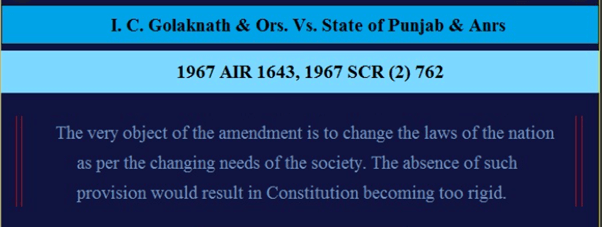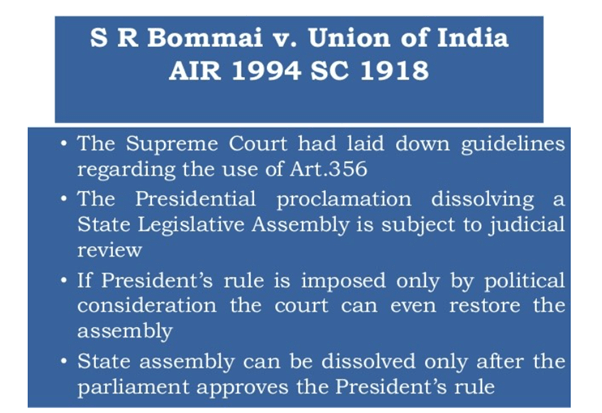Basic Structure Doctrine: Landmark Cases in Indian Polity | Indian Polity for UPSC CSE PDF Download
Introduction
- According to the Indian Constitution, the Parliament and the State Legislatures can make laws within their jurisdictions.
- The power to amend the Constitution is only with the Parliament and not the state legislative assemblies.
- However, this power of the Parliament is not absolute.
- The Supreme Court has the power to declare any law that it finds unconstitutional void.
- As per the Basic Structure Doctrine, any amendment that tries to change the basic structure of the constitution is invalid.

Basic Structure Doctrine
- There is no mention of the term “Basic Structure” anywhere in the Indian Constitution. The idea that the Parliament cannot introduce laws that would amend the basic structure of the constitution evolved gradually over time and in many cases.
- The idea is to preserve the nature of Indian democracy and protect the rights and liberties of people. This doctrine helps to protect and preserve the spirit of the constitution document.
- It was the Kesavananda Bharati case that brought this doctrine into the limelight. It held that the “basic structure of the Constitution could not be abrogated even by a constitutional amendment”.

The judgement listed some basic structures of the constitution as:
- Supremacy of the Constitution
- Unity and sovereignty of India
- The democratic and republican form of government
- Federal character of the Constitution
- Secular character of the Constitution
- Separation of power
- Individual freedom
Over time, many other features have also been added to this list of basic structural features.
Some of them are:
- Rule of law
- Judicial review
- Parliamentary system
- Rule of equality
- Harmony and balance between the Fundamental Rights and DPSP
- Free and fair elections
- Limited power of the parliament to amend the Constitution
- Power of the Supreme Court under Articles 32, 136, 142 and 147
- Power of the High Court under Articles 226 and 227
Any law or amendment that violates these principles can be struck down by the SC on the grounds that they distort the basic structure of the Constitution.
Evolution of the Basic Structure Concept
The concept of the basic structure of the constitution evolved over time. In this section, we shall discuss this evolution with the help of some landmark judgement related to this doctrine.
Shankari Prasad Case (1951):
- In this case, the SC contended that the Parliament’s power of amending the Constitution under Article 368 included the power to amend the Fundamental Rights guaranteed in Part III as well.
Sajjan Singh case (1965):
- In this case, also, the SC held that the Parliament can amend any part of the Constitution including the Fundamental Rights.
- It is noteworthy to point out that two dissenting judges, in this case, remarked whether the fundamental rights of citizens could become a plaything of the majority party in Parliament.
Golaknath case (1967):

- In this case, the court reversed its earlier stance that the Fundamental Rights can be amended.
- It said that Fundamental Rights are not amenable to the Parliamentary restriction as stated in Article 13 and that to amend the Fundamental rights a new Constituent Assembly would be required.
- Also stated that Article 368 gives the procedure to amend the Constitution but does not confer on Parliament the power to amend the Constitution. This case conferred upon Fundamental Rights a ‘transcendental position’.
- The majority judgement called upon the concept of implied limitations on the power of the Parliament to amend the Constitution. As per this view, the Constitution gives a place of permanence to the fundamental freedoms of the citizens.
- In giving to themselves the Constitution, the people had reserved these rights for themselves.
Kesavananda Bharati case (1973):

- This was a landmark case in defining the concept of the basic structure doctrine.
- The SC held that although no part of the Constitution, including Fundamental Rights, was beyond the Parliament’s amending power, the “basic structure of the Constitution could not be abrogated even by a constitutional amendment.”

- The judgement implied that the parliament can only amend the constitution and not rewrite it. The power to amend is not a power to destroy.
- This is the basis in Indian law in which the judiciary can strike down an amendment passed by Parliament that is in conflict with the basic structure of the Constitution.
Indira Nehru Gandhi v. Raj Narain case (1975):

- Here, the SC applied the theory of basic structure and struck down Clause(4) of Article 329-A, which was inserted by the 39th Amendment in 1975 on the grounds that it was beyond the Parliament’s amending power as it destroyed the Constitution’s basic features.
- The 39th Amendment Act was passed by the Parliament during the Emergency Period. This Act placed the election of the President, the Vice President, the Prime Minister and the Speaker of the Lok Sabha beyond the scrutiny of the judiciary.
- This was done by the government in order to suppress Indira Gandhi’s prosecution by the Allahabad High Court for corrupt electoral practices.
Minerva Mills case (1980):

- This case again strengthens the Basic Structure doctrine. The judgement struck down 2 changes made to the Constitution by the 42nd Amendment Act 1976, declaring them to be violative of the basic structure.
- The judgement makes it clear that the Constitution, and not the Parliament is supreme.
- In this case, the Court added two features to the list of basic structural features. They were: judicial review and balance between Fundamental Rights and DPSP.
- The judges ruled that a limited amending power itself is a basic feature of the Constitution.
Waman Rao Case (1981):
- The SC again reiterated the Basic Structure doctrine.
- It also drew a line of demarcation as April 24th, 1973 i.e., the date of the Kesavananda Bharati judgement, and held that it should not be applied retrospectively to reopen the validity of any amendment to the Constitution which took place prior to that date.
- In the Kesavananda Bharati case, the petitioner had challenged the Constitution (29th Amendment) Act, 1972, which placed the Kerala Land Reforms Act, 1963 and its amending Act into the 9th Schedule of the Constitution.
- The 9th Schedule was added to the Constitution by the First Amendment in 1951 along with Article 31-B to provide a “protective umbrella” to land reforms laws.
- This was done in order to prevent them from being challenged in court.
- Article 13(2) says that the state shall not make any law inconsistent with fundamental rights and any law made in contravention of fundamental rights shall be void.
- Now, Article 31-B protects laws from the above scrutiny. Laws enacted under it and placed in the 9th Schedule are immune to challenge in a court, even if they go against fundamental rights.
- The Waman Rao case held that amendments made to the 9th Schedule until the Kesavananda judgement are valid, and those passed after that date can be subject to scrutiny.
Indra Sawhney and Union of India (1993):

- SC examined the scope and extent of Article 16(4), which provides for the reservation of jobs in favour of backward classes. It upheld the constitutional validity of 27% reservation for the OBCs with certain conditions (like creamy layer exclusion, no reservation in promotion, the total reserved quota should not exceed 50%, etc.)
- Here, the ‘Rule of Law’ was added to the list of basic features of the constitution.
S.R. Bommai case (1994):

- In this judgement, the SC tried to curb the blatant misuse of Article 356 (regarding the imposition of the President’s Rule on states).
- In this case, there was no question of constitutional amendment but even so, the concept of basic doctrine was applied.
- The Supreme Court held that policies of a state government directed against an element of the basic structure of the Constitution would be a valid ground for the exercise of the central power under Article 356.
The doctrine of the basic structure helps to prevent legislative excesses, as was evident in the Emergence Era. This is required as a shield against an all-powerful parliament, which can resort to overuse of Article 368. There is another school of thought, however, that says that if amendments help a constitution to survive, they must include changes in the allegedly basic part of the Constitution.
|
142 videos|779 docs|202 tests
|
FAQs on Basic Structure Doctrine: Landmark Cases in Indian Polity - Indian Polity for UPSC CSE
| 1. What is the Basic Structure Doctrine in Indian Polity? |  |
| 2. Which landmark case established the Basic Structure Doctrine in Indian Polity? |  |
| 3. What are some examples of the basic features protected under the Basic Structure Doctrine? |  |
| 4. Can the Parliament amend the Constitution if it violates the Basic Structure Doctrine? |  |
| 5. Has the Basic Structure Doctrine been applied in any recent cases in Indian Polity? |  |






















